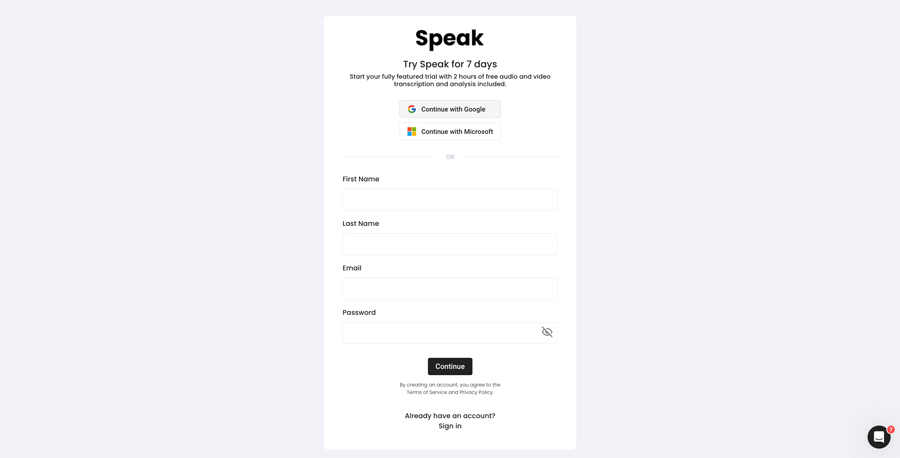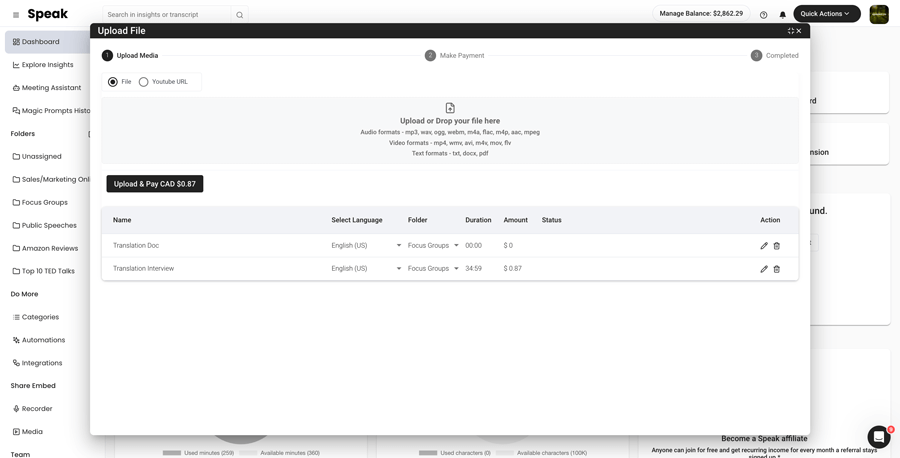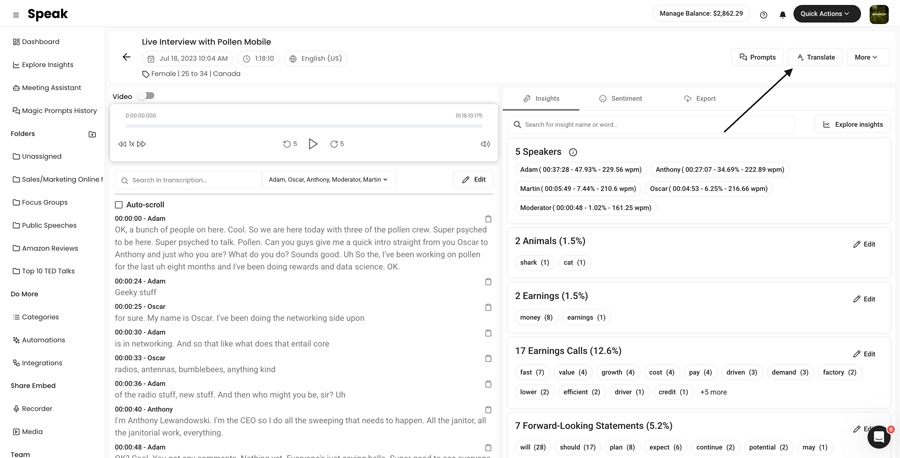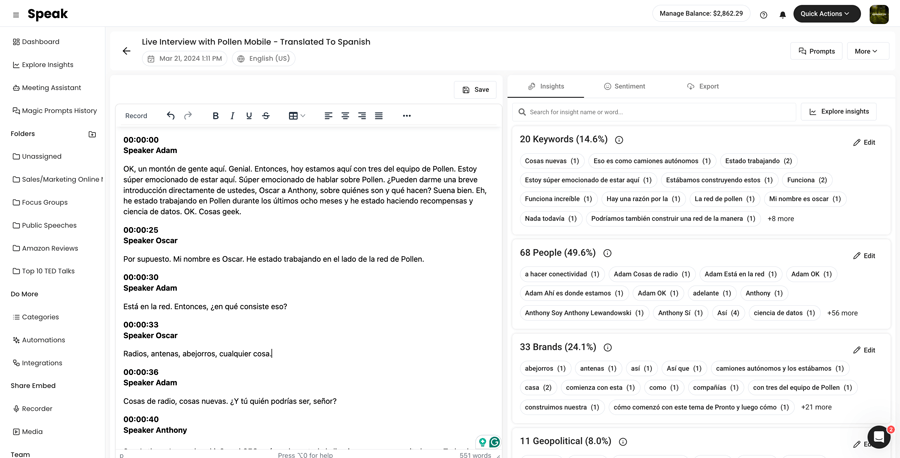How To Translate Chinese (Simplified) to Chinese (Traditional)
Translating Chinese (Simplified) to Chinese (Traditional) is super simple!

Step 1: Register for Speak
Register for Speak using this link.
Once you register, you can instantly begin translating your Chinese (Simplified) to Chinese (Traditional) file(s).

Step 2: Upload Your Chinese (Simplified) file(s)
As soon as you log in, you will be redirected to the dashboard.
Once there, you can select the Quick Action “New Upload”.
In Speak, you can seamlessly upload, transcribe and translate audio, video and text files all at once!

Step 3: Translate Your Chinese (Simplified) file(s) to Chinese (Traditional)
Once the file is uploaded, simply visit your file and select “Translate”.
If it is an audio and video file, Speak will ask you if you want to keep the speaker names and timestamps in the translation.
Want to translate many files at once? No problem!
You can view the files you want to automatically translate from Chinese (Simplified) to Chinese (Traditional) from the folder level and instantly translate as many files as you need with our artificial intelligence translation in just a few clicks.

Step 4: That’s It! View, Analyze, Modify & Export Your New Chinese (Traditional) file(s)
Once the translation is done, you will be alerted and you will see a new document in the same folder your original file is in.
The file will be named the same but with a dash indicating that it is the translated version.
Need support with your Chinese (Simplified) translation?
We are always here and happy to help at Speak!
Just send us a message on live chat on the bottom right corner and we will ensure you are set up for success.
Interested in translating Chinese (Simplified) or other languages to different languages? View our entire list of supported translation languages here.
Automatic, accurate, instant AI translation from Chinese (Simplified) to Chinese (Traditional) is here for you.
Register for Speak using this link and begin translating Chinese (Simplified) to Chinese (Traditional) today.
Unlocking New Horizons: Translate Chinese (Simplified) to Chinese (Traditional)
In an era where communication transcends borders, the power to seamlessly convert languages becomes indispensable. This stands especially true for variants of one of the most widely spoken languages in the world – Chinese. The conversion from Chinese (Simplified) to Chinese (Traditional) is not just a linguistic preference but a bridge connecting cultures, businesses, and research communities across the globe. Speak Ai, leveraging AI translation, and NLP technologies, aims to make this transition effortless, accurate, and incredibly efficient for over 150K users.
Understanding the Landscape
Before delving into the depths of translation capabilities and their significance, let’s establish an understanding of where and why these two variants hold importance.
Geographical Dominance and Historical Significance
Chinese (Simplified) and Chinese (Traditional) span vast geographies, reflecting historical, cultural, and political narratives. Simplified Chinese predominantly prevails in Mainland China and Singapore, a result of linguistic reforms aimed at literacy improvement. Traditional Chinese continues to flourish in Hong Kong, Taiwan, and Macau, revered for preserving the heritage and intricacies of ancient Chinese script.
Statistics to Ponder
With over a billion native speakers, the Chinese language, in both its forms, commands a significant presence in global communication, stressing the importance of accurate translation services like those offered by Speak Ai.
The Essence of Translation: From Simplified to Traditional
Enhanced Cultural Connection
Translating from Chinese (Simplified) to Chinese (Traditional) transcends mere linguistic conversion; it’s about fostering deeper understanding and connections across Chinese-speaking communities.
Potential Market Expansion
Businesses aiming to penetrate markets in Taiwan, Hong Kong, and other regions where Traditional Chinese is prevalent can leverage Speak Ai’s translation services for marketing materials, product descriptions, and more, driving growth and expansion.
Boosted Research and Development
Researchers and academics can access a broader spectrum of literature and studies, breaking language barriers that once hindered innovation and knowledge sharing.
Speak Ai: Revolutionizing Chinese Translation
Accuracy Meets Efficiency
With Speak Ai, experience precision powered by NLP and large language models, ensuring your translations capture the nuances of Chinese dialects flawlessly.
Seamless Integration with Your Workflow
Our AI Meeting Assistant effortlessly transcribes and translates meetings held via Microsoft Teams, Zoom, Google Meet, and Webex, ensuring no detail is lost in translation.
Time and Cost Savings
Automating the translation process drastically reduces the time and financial resources needed, compared to traditional methods, facilitating quicker decision-making and project advancements.
Real-World Applications: Bridging the Gap
From business contracts and academic research to multilingual content creation and global conferences, the ability to flawlessly translate between Chinese (Simplified) and Chinese (Traditional) serves as a linchpin for diverse sectors, empowering individuals and organizations to achieve their global ambitions.
Conclusion: Your Gateway to Global Chinese Communication
In the interconnected world of today, the value of bridging linguistic divides cannot be overstated. Speak Ai stands at the forefront, offering intuitive, reliable, and sophisticated translation services that promise not just to translate but to connect. Transitioning between Chinese (Simplified) and Chinese (Traditional) has never been more seamless, opening up new avenues for exploration, collaboration, and growth. Embrace the future of communication with Speak Ai, where language is no longer a barrier but a gateway to endless possibilities.
Discover the Speak Ai Advantage
Join the 150K+ satisfied users experiencing the transformational benefits of Speak Ai’s translation services. With a 4.9 rating on G2, our commitment to excellence is unwavering. Embark on your journey to transcend language barriers. Sign up today and unlock the full potential of your global ambitions.
FAQs: Delving Deeper into Chinese Language Variants
Where are Chinese (Simplified) and Chinese (Traditional) popular?
Chinese (Simplified) is widely used in Mainland China and Singapore, while Chinese (Traditional) finds its stronghold in Taiwan, Hong Kong, and Macau. This distribution reflects both modern linguistic reforms and the preservation of cultural heritage.
Interesting Stats on Populations and History
The adoption of Simplified Chinese in the 1950s and 1960s was aimed at improving literacy rates, whereas Traditional Chinese remains a bastion of cultural heritage and historical continuity across certain regions, underscoring the rich tapestry of Chinese linguistic evolution.
Fun Facts About the Chinese Language
Dialects aside, Chinese characters, whether Simplified or Traditional, have been in use for thousands of years, with some of the oldest written records dating back to the Shang dynasty. This historical depth adds layers of meaning and cultural significance to each character.
Differences and Similarities Between Chinese (Simplified) and Chinese (Traditional)
While both variants share the same grammatical structure and core vocabulary, they differ primarily in character complexity. Simplified characters have reduced strokes for easier learning and writing, whereas Traditional characters maintain their historical form. Despite these differences, understanding one variant offers a foundational bridge to learning the other, reflecting the interconnectedness of Chinese linguistic heritage.
Embrace the future of communication with Speak Ai’s cutting-edge translation technology, designed for today’s researchers, businesses, and global communicators.
Translate Chinese (Simplified) To These Other Supported Languages:
- Translate Chinese (Simplified)-to-Albanian
- Translate Chinese (Simplified)-to-Amharic
- Translate Chinese (Simplified)-to-Arabic (Egypt)
- Translate Chinese (Simplified)-to-Arabic (Iraq)
- Translate Chinese (Simplified)-to-Arabic (Israel)
- Translate Chinese (Simplified)-to-Arabic (Jordan)
- Translate Chinese (Simplified)-to-Arabic (Kuwait)
- Translate Chinese (Simplified)-to-Arabic (Lebanon)
- Translate Chinese (Simplified)-to-Arabic (Oman)
- Translate Chinese (Simplified)-to-Arabic (Palestinian Authority)
- Translate Chinese (Simplified)-to-Arabic (Qatar)
- Translate Chinese (Simplified)-to-Arabic (Saudi Arabia)
- Translate Chinese (Simplified)-to-Arabic (Syrian Arab Republic)
- Translate Chinese (Simplified)-to-Arabic (United Arab Emirates)
- Translate Chinese (Simplified)-to-Arabic Modern Standard (Bahrain)
- Translate Chinese (Simplified)-to-Armenian
- Translate Chinese (Simplified)-to-Azerbaijani
- Translate Chinese (Simplified)-to-Bengali
- Translate Chinese (Simplified)-to-Bosnian
- Translate Chinese (Simplified)-to-Bulgarian
- Translate Chinese (Simplified)-to-Catalan
- Translate Chinese (Simplified)-to-Chinese (Cantonese, Traditional)
- Translate Chinese (Simplified)-to-Chinese (Simplified)
- Translate Chinese (Simplified)-to-Chinese (Traditional)
- Translate Chinese (Simplified)-to-Croatian
- Translate Chinese (Simplified)-to-Czech
- Translate Chinese (Simplified)-to-Danish
- Translate Chinese (Simplified)-to-Dari
- Translate Chinese (Simplified)-to-Dutch
- Translate Chinese (Simplified)-to-English
- Translate Chinese (Simplified)-to-English (Australia)
- Translate Chinese (Simplified)-to-English (India)
- Translate Chinese (Simplified)-to-English (Ireland)
- Translate Chinese (Simplified)-to-English (New Zealand)
- Translate Chinese (Simplified)-to-English (Scottish)
- Translate Chinese (Simplified)-to-English (South African)
- Translate Chinese (Simplified)-to-English (United Kingdom)
- Translate Chinese (Simplified)-to-English (United States)
- Translate Chinese (Simplified)-to-Estonian
- Translate Chinese (Simplified)-to-Farsi (Persian)
- Translate Chinese (Simplified)-to-Finnish
- Translate Chinese (Simplified)-to-French
- Translate Chinese (Simplified)-to-French (Canada)
- Translate Chinese (Simplified)-to-Georgian
- Translate Chinese (Simplified)-to-German
- Translate Chinese (Simplified)-to-German (Swiss)
- Translate Chinese (Simplified)-to-Greek
- Translate Chinese (Simplified)-to-Gujarati
- Translate Chinese (Simplified)-to-Haitian Creole
- Translate Chinese (Simplified)-to-Hausa
- Translate Chinese (Simplified)-to-Hebrew
- Translate Chinese (Simplified)-to-Hindi
- Translate Chinese (Simplified)-to-Hungarian
- Translate Chinese (Simplified)-to-Icelandic
- Translate Chinese (Simplified)-to-Indonesian
- Translate Chinese (Simplified)-to-Irish
- Translate Chinese (Simplified)-to-Italian
- Translate Chinese (Simplified)-to-Japanese
- Translate Chinese (Simplified)-to-Kannada
- Translate Chinese (Simplified)-to-Kazakh
- Translate Chinese (Simplified)-to-Korean
- Translate Chinese (Simplified)-to-Latvian
- Translate Chinese (Simplified)-to-Lithuanian
- Translate Chinese (Simplified)-to-Macedonian
- Translate Chinese (Simplified)-to-Malay
- Translate Chinese (Simplified)-to-Malayalam
- Translate Chinese (Simplified)-to-Maltese
- Translate Chinese (Simplified)-to-Marathi
- Translate Chinese (Simplified)-to-Mongolian
- Translate Chinese (Simplified)-to-Norwegian
- Translate Chinese (Simplified)-to-Pashto
- Translate Chinese (Simplified)-to-Persian
- Translate Chinese (Simplified)-to-Polish
- Translate Chinese (Simplified)-to-Portuguese
- Translate Chinese (Simplified)-to-Portuguese (Brazilian)
- Translate Chinese (Simplified)-to-Portuguese (Portugal)
- Translate Chinese (Simplified)-to-Punjabi
- Translate Chinese (Simplified)-to-Romanian
- Translate Chinese (Simplified)-to-Russian
- Translate Chinese (Simplified)-to-Serbian
- Translate Chinese (Simplified)-to-Sinhala
- Translate Chinese (Simplified)-to-Slovak
- Translate Chinese (Simplified)-to-Slovenian
- Translate Chinese (Simplified)-to-Somali
- Translate Chinese (Simplified)-to-Spanish
- Translate Chinese (Simplified)-to-Spanish (Mexico)
- Translate Chinese (Simplified)-to-Swahili
- Translate Chinese (Simplified)-to-Swedish
- Translate Chinese (Simplified)-to-Tamil
- Translate Chinese (Simplified)-to-Telugu
- Translate Chinese (Simplified)-to-Thai
- Translate Chinese (Simplified)-to-Turkish
- Translate Chinese (Simplified)-to-Ukrainian
- Translate Chinese (Simplified)-to-Urdu
- Translate Chinese (Simplified)-to-Uzbek
- Translate Chinese (Simplified)-to-Vietnamese
- Translate Chinese (Simplified)-to-Welsh



